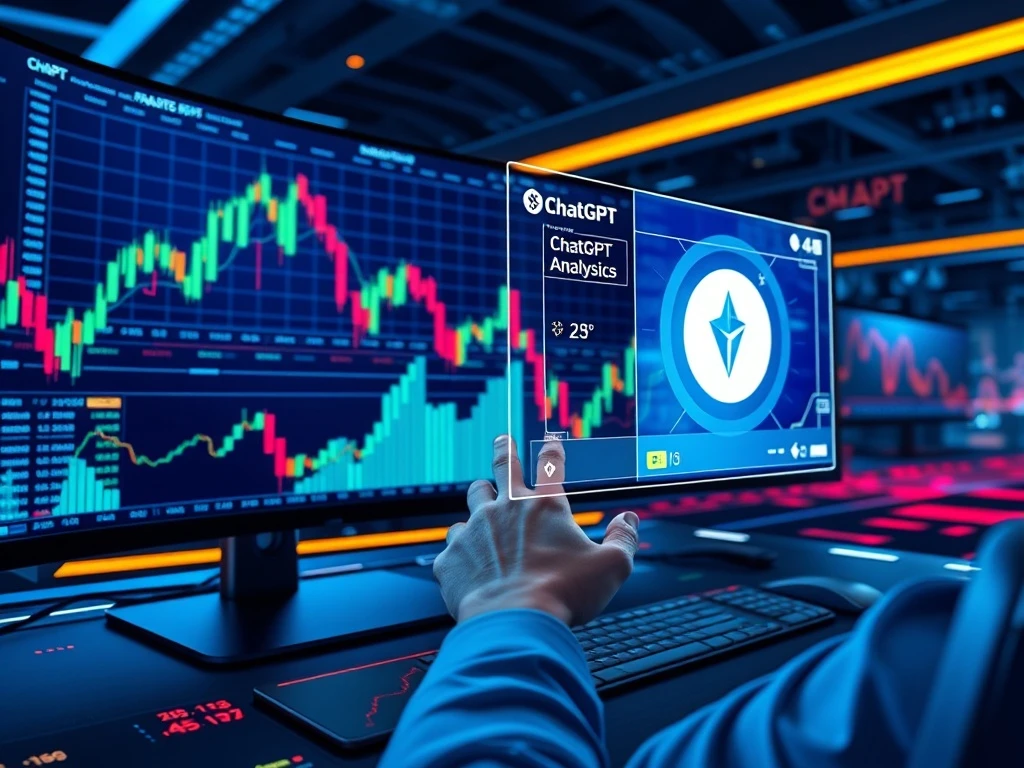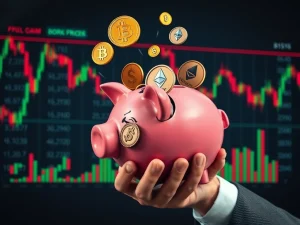Unleash Powerful Real-Time Crypto Trading Signals with ChatGPT

The cryptocurrency market moves at an incredible speed. Thousands of data points emerge every minute. These include news feeds, social media updates, on-chain metrics, and technical charts. For modern traders, the main challenge is not finding information. Instead, it is processing that data effectively. Traders seek a clear, actionable signal amid the constant noise. This is where artificial intelligence, specifically a large language model like ChatGPT, becomes indispensable. It transforms from a novelty into an analytical co-pilot. This guide shows how to integrate ChatGPT crypto trading into your workflow. It helps you gain an edge in the volatile crypto markets.
Understanding ChatGPT’s Role in Crypto Trading
Before diving into practical applications, establishing ground rules for using ChatGPT is crucial. Ignoring these rules can lead to flawed conclusions and potential losses. The free public version of ChatGPT cannot connect directly to market data APIs. However, ChatGPT Plus and Pro users can access live internet browsing. This allows for real-time crypto signals updates, such as current Bitcoin prices or the latest news. Its core strength lies in analyzing and interpreting data you provide. ChatGPT’s outputs are not investment advice. It serves as a tool for data processing and language interpretation. Therefore, you remain fully responsible for every financial decision. The utility of ChatGPT depends entirely on the quality, accuracy, and timeliness of the information you feed it. Flawed data will inevitably lead to flawed analysis.
ChatGPT accelerates crypto analysis. It interprets complex data, summarizes market sentiment, and creates strategy templates. Traders use it for practical tasks. These include bot development, technical interpretation, and backtesting simulations. It augments human decisions, rather than replacing them. ChatGPT works best when combined with specialized tools. Platforms like TradingView are excellent companions. Key limitations include inconsistent real-time data access. Furthermore, it relies on clear prompts and human oversight for accuracy.
Setting Up Your AI Market Analysis Toolkit
To use ChatGPT effectively, you must first become a proficient data gatherer. Your goal is to collect high-quality information. Use specialized platforms for this purpose. Then, use ChatGPT as the central processor. It helps connect the dots. A professional setup includes three key components:
-
Source of Truth for Price Data: This component is non-negotiable. A platform like TradingView is essential. It provides real-time price action, volume data, and various technical indicators. Accurate price data forms the foundation of any sound trading decision.
-
Trusted Source for Narratives: The crypto market often moves based on stories and trends, known as narratives. Use trusted sources or specialized news terminals. Stay informed about regulatory changes, technological upgrades, and major partnerships. These narratives drive capital flows.
-
Source for Fundamental Data: For deeper analysis, tools like Glassnode, Nansen, or Santiment are invaluable. They offer insights into a network’s underlying health. This includes data on exchange inflows/outflows, whale wallet activity, and network growth metrics. Such data often precedes significant price action.
With these tools, you can feed ChatGPT the high-quality information it needs. This ensures it produces a high-quality AI market analysis. This structured approach helps in making informed decisions.
Generating Crypto Trading Strategies with ChatGPT
This methodical process guides you. It moves from a high-level market overview to a specific, well-defined trading strategy. Each step builds upon the previous one. This ensures a comprehensive analysis.
Step 1: Identify the Macro Market Narrative
Crypto capital flows in waves. It often chases the most compelling current story. Is the market currently excited about AI-related tokens? Is it focused on real-world asset (RWA) tokenization? Or perhaps the latest layer-2 scaling solutions? Your first task is to use ChatGPT to identify these dominant narratives. Go to your news aggregator. Collect the headlines and the first paragraph of the top 10-15 crypto market news stories from the past three to five days. Then, use this prompt:
Prompt: “Act as a cryptocurrency market analyst. I will provide you with a list of recent news headlines and summaries. Your task is to analyze this information and identify the top 2-3 dominant market narratives for August 2025. Categorize each narrative (e.g., ‘AI and Blockchain Integration,’ ‘Regulatory Developments,’ ‘DeFi 2.0,’ ‘Real World Asset Tokenization’). For each dominant narrative, explain why it appears to be gaining traction based on the provided text.”
Example News Items:
“BlackRock files for tokenized treasury bond fund, leveraging Chainlink CCIP for cross-chain settlement.”
“Helium Network’s 5G coverage surpasses 1,000 US cities, driving HNT token burn rate to new highs.”
“SEC chairman indicates a clearer path for tokenized securities, boosting confidence in the RWA sector.”
“IO.net announces major partnership with Render Network to pool GPU resources for AI startups.”
“JPMorgan Chase report highlights real-world asset tokenization as a potential $10-trillion market by 2030.”
“Filecoin sees surge in enterprise data storage contracts following network upgrade.”
This analysis provides a crucial filter. You move beyond randomly scanning hundreds of coins. Instead, you get a focused list of sectors. Market attention and capital are currently flowing into these sectors. If “AI and blockchain integration” is a hot narrative, your next steps will focus on assets within that category. This helps in developing targeted crypto trading strategies.
Step 2: Measure Market Sentiment with ChatGPT
Once you have identified a narrative and a potential asset, like Fetch.ai’s FET, your next step is to gauge real-time sentiment. Spend a few minutes browsing the asset’s official X page, its subreddit, and what prominent, credible influencers are saying. Take brief notes on key discussion points, both positive and negative. Use the following prompt:
Prompt: “Analyze the following summary of community sentiment for Fetch.ai (FET). Classify the sentiment as predominantly Bullish, Bearish, or Neutral. Identify the primary bullish catalysts and the primary bearish concerns being discussed.”
Example Sentiment Points:
Bullish: Strong AI/agent/ASI narrative, owning its own LLM and infrastructure. This offers differentiation. Major institutional interest, such as Interactive Strength’s $500-million token acquisition plan. The community believes the price is cheap relative to potential/peers, seeing significant upside.
Bearish: Product execution and performance issues. Slow features, unpolished betas, and questions about agent tech functionality. Tokenomics/supply and holder concentration. Fears exist about big holders and centralization risks. Dependency on altseason/market cycles. Many believe gains rely on broader market strength, not just FET fundamentals.
Neutral: Price movements are viewed with caution. Recent gains are welcomed, but many feel FET is still far below its all-time highs. The risk of support levels failing is also frequently mentioned. Technical chart watchers point to resistance zones and Fibonacci levels. Some believe in possible upside if certain barriers are broken. Others warn of pullbacks or stagnation. Ranges/“neutral phases” in price action are common. People note FET trading in a defined band. A breakout above resistance or breakdown below support will be important.
This output gives you qualitative context behind the price. A chart might appear bullish. However, if underlying sentiment turns negative due to valid concerns, such as token unlocks, it could be a red flag. Strong positive sentiment, driven by tangible developments, can boost confidence in a bullish technical setup. This provides crucial insights for your real-time crypto signals.
Step 3: Interpretation of Technical Data with TradingView Integration
This is where you use ChatGPT as an unbiased technical analysis textbook. You provide objective data from your charting platform. It then provides a neutral interpretation. Open your charting platform for your chosen asset. Note the key values for the price and your preferred indicators on a specific timeframe, for example, the daily chart. This step often involves a robust TradingView integration.
Prompt: “Act as a technical analyst. Provide a neutral interpretation of the following technical data for the Avalanche (AVAX)/USD daily chart. Do not provide financial advice. Price Action: The price has just broken above a key resistance level at $75, which was the high from the previous quarter. Volume: The breakout candle was accompanied by trading volume that was 150% higher than the 20-day average volume. RSI (Relative Strength Index): The daily RSI is at 68. It is in bullish territory but is approaching the overbought level of 70. Moving Averages: The 50-day moving average has just crossed above the 200-day moving average, a pattern known as a ‘Golden Cross.’ Your Task: Explain what this combination of indicators typically suggests in a market context. What would a technical trader look for as a sign of continuation for this bullish move? What specific signs (e.g., price action, volume) would suggest that this breakout is failing (a ‘fakeout’)?”
The output provides a neutral reading on Avalanche’s (AVAX) chart. It shows how traders view the breakout above $75, strong volume, near-overbought RSI, and a golden cross. This serves as a guide. It helps spot continuation (holding above $75 with strong volume) versus a fakeout (dropping back below on weak volume or reversals). This framework can be reused for other charts. It does not offer financial advice. This step enhances your AI market analysis capabilities significantly.
Step 4: Synthesize Data into a Structured Trade Thesis
This final step brings everything together. You feed all your gathered intelligence into ChatGPT. This includes narrative, sentiment, and technicals. The goal is to formulate a complete, logical trade plan. Consolidate the key takeaways from the previous three steps into a single block of text. Then, use this prompt:
Prompt: “Create a comprehensive and objective trade thesis for Chainlink (LINK) based solely on the data I provide below. Structure the output into three sections: 1) The Bullish Case, 2) Potential Risks and Bearish Factors, and 3) An Invalidation Thesis. Provided data: Narrative: The market’s dominant narrative is ‘real-world asset tokenization,’ and Chainlink is consistently mentioned as a core infrastructure piece for this trend. Sentiment: Sentiment is highly positive due to the recent announcement of the Cross-Chain Interoperability Protocol (CCIP) being adopted by a major global banking consortium. Technical analysis: LINK has broken out of a six-month accumulation range, clearing the $45 resistance level on high volume. The daily RSI is 66.”
The output serves as an objective framework. It outlines positive drivers (bullish case) and key vulnerabilities (risks). It also defines clear conditions that would negate the setup (invalidation). This allows for structured monitoring of Chainlink’s price action and narrative strength. It does so without making financial recommendations. This approach refines your crypto trading strategies and helps manage risk effectively.
The Future of ChatGPT-Powered Trading
The four-step framework provides a systematic method. It links high-level market narratives, like RWAs, with asset-specific data points and technical analysis. This process demonstrates ChatGPT’s utility as an analytical tool. It synthesizes user-provided information. Within this workflow, the model structures qualitative data from news and social media. It interprets quantitative technical inputs. It formulates outputs based on defined parameters in a prompt. Importantly, the model does not perform independent analysis. It also does not provide financial advice. The user holds final responsibility for validating data. They assess risks and execute any trade. Adopting this human-led, AI-assisted workflow promotes a more structured approach. It encourages disciplined market analysis. This article does not contain investment advice or recommendations. Every investment and trading move involves risk. Readers should conduct their own research when making decisions.







